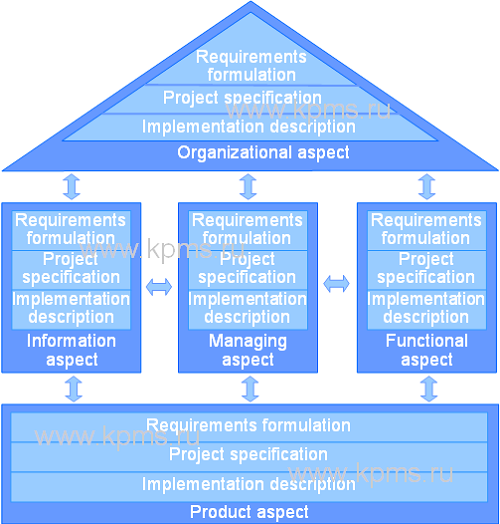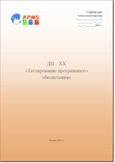ARIS is one of the most popular and effective tools used for modeling and analyzing business processes. ARIS (Architecture of Integrated Information System) was positioned as a CASE tool initially. The emphasis was placed on process modeling further. It is a platform for managing and improving business processes now, consisting of software products for various purposes. The ninth version of ARIS includes more than a dozen products.
ARIS
ARIS modeling is based on a methodology developed by Professor Scheer (Prof. Scheer A.ЦW.). The model should represent the process as a single, integral element of the organization business structure. The process is modeled in several aspects in order to preserve this integrity.
Each process can be considered in five aspects according to the ARIS methodology:
- organizational aspect Ц it is a set of organizational units, their interrelations and relevant structures involved in the process;
- information aspect Ц it displays the composition of data and information involved in the process;
- managing aspect Ц it describes the relationship between different types of process models;
- functional aspect Ц it contains descriptions of functions, individual sub functions and their relationships with each other, and with the main functions;
- product aspect Ц it determines the composition of products and process resources, as well as their relationship with each other and with elements of other models.
These aspects represent the ARIS architecture. Each aspect of the ARIS architecture contains different types of models in order to describe processes and build models. Models allow you to represent a wide range of processes in terms of data, functions, organizational units, resources, materials, including the relationships between them.
The process model can be detailed by levels within each of the aspects. The levels depend on the "proximity" of the model to formal programming languages and the creation of information systems.
ARIS divides models into three levels of detail:

- requirements formulation level. The models of this level belong to semantic models because this level is closer to the description of business problems. This level describes the functions, tasks, documents, various resources and products involved in the business process.
- project specification level. The ARIS model represents elements related to information technology at this level. The transition from the concepts of business processes to the concepts of information systems is carried out here. Models of this level describe user-defined and modular transactions that perform elements of a business process.
- implementation description level. This level is nearest to information systems. Models of this level contain descriptions of hardware and software components.
All models and their descriptions used in ARIS are based on a common semantic representation, so that a relationship can be easily built between different models and their elements.
ARIS possibility
ARIS software products are an integrated environment that includes a large number of components. These components provide opportunities for modeling and analyzing processes, developing the architecture of information system and its integration with the SAP R3 automation system, data analysis and management, etc.
The ninth version of the ARIS business platform includes the following components:
- ARIS Architect & Designer. This component is designed for static modeling of processes. Various methods and notations are used for modeling. The component includes more than 150 types of diagrams that provide analysis and modeling of processes in all aspects of the ARIS methodology.
- ARIS Business Strategy. The component is an extension for ARIS Architect & Designer. It provides the development and management of the business strategy of the organization. It is possible to model and analyze the value of the organization's processes due to this component.
- ARIS Connect. This is a tool that allows you to work collectively with models. This component implements the possibility of remote work using mobile devices. The work is based on the principle of a social network.
- ARIS Enterprise Architecture. This component is also an extension for ARIS Architect & Designer. It allows you to analyze and harmonize the documentation of the enterprise with the IT architecture.
- ARIS for ArchiMate. It is an extension for ARIS Design Server. This component allows you to create IT architecture models using ArchiMate and TOGAF standards.
- ARIS for DMS. It is an extension for ARIS Architect & Designer. It allows you to access and exchange data between the ARIS repository and documentation management systems.
- ARIS for SAP Solutions. This component is an extension of ARIS Architect & Designer and allows you to synchronize business process models with the SAP R3 environment.
- ARIS IT Inventory. This is extension for ARIS Architect & Designer, which allows you to take inventory of applications, technologies and projects.
- ARIS MashZone. This component allows you to create interactive control panels for working with various types of data.
- ARIS Process Governance. This is an extension for ARIS Architect & Designer. You can set policies, roles, and responsibilities for managing business processes and include these policies in the models.
- ARIS Process Performance Manager. This component is used to monitor and analyze process indicators such as productivity, cost and quality.
- ARIS Publisher. This is an extension for ARIS Architect & Designer. This extension allows to easily access for employees to information about processes and IT architecture.
- ARIS Risk & Compliance Manager. This component is used for risk management and for inclusion of a risk management system in the process model.
- ARIS Simulation. It is used for dynamic modeling of processes. You can reengineer, optimize and analyze business processes, as well as carry out resource planning with this component. The component is an extension for ARIS Architect & Designer.
- ARIS UML Designer. ARIS models can be presented in the form of a UML standard with this component, which ensures the compatibility of business models and IT models.
- ARIS Viewer. This is a component that allows you to view all the ARIS repository information in ARIS Publisher, access information in ARIS IT Inventory and manage ARIS Process Governance tasks via a web interface.
Detailed information of ARIS components and their capabilities can be found on the website of the SOFTWARE AG.
ARIS advantages
ARIS platform is a comfortable and effective tool for business processes modeling. It provides support for the work of both business analysts and IT specialists implementing information systems.
It is possible to single out advantages of this platform for the purposes of modeling business processes:
- Well-developed graphical interface. Users can create models using a system of graphic symbols. It is possible to use the web interface. The full-screen mode and navigation system allows you to present data in a comfortable way. The interface can be configured for users needs.
- Support for powerful data storage. The ARIS data warehouse contains a large number of elements and descriptions. Users can work together with data warehouse objects.
- Integration with other software products. ARIS allows you to import process models into software products that support standard interfaces, for example, such as XML, XMI, WSDL, XSD, XPDL, CADM (DoDAF), BPEL, BPML Export, Visio, txt and Excel.
- Detailing of models. It is possible to detail models and their components using various aspects in ARIS.
- Dynamic modeling. It is possible to carry out discrete execution of process actions if use of additional tools. ARIS provides graphical tools for monitoring and analyzing actions in process models.
- Generating reports. It is possible to use the installed set of reports, as well as customize reports to meet the needs of users. Reports can be generated in publicly available formats, such as MS WORD/EXCEL, Adobe PDF, HTML. Graphical models can also be presented in reports. They are presented in available formats such as WMF, GIF, JPG, and BMP.
- Support for multi-user work. ARIS allows a different number of users to work on business process models - from one to several hundred people. Users can be located in different geographical regions.
